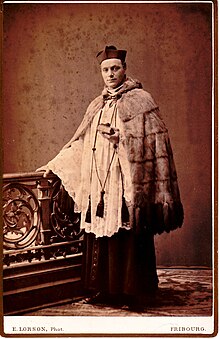
An almuce was a hood-like shoulder cape worn as a choir vestment in the Middle Ages, especially in England. Initially, it was worn by the general population.[1] It found lasting use by certain canons regular, such as the white almutium worn on the arm by Premonstratensian canons. Use of fur-lined almuce was against the rules of the canons, leading to requests for dispensations from the rule, as described by Alison Fizzard.[2] It also survives in the tippet and hood worn by some Anglican priests.
The almuce or amess is defined by E. L. Cutts as a tippet of black cloth with a hood attached, lined with fur, worn in choir by canons, and in some counties of England by parochial rectors.[3] The academic hood is a derivative from the medieval almuce.
The almuce was originally a head-covering only, worn by the clergy, but adopted also by the laity, and the German word Mütze "cap" and Swedish mössa[4] "toque" is later than the introduction of the almuce in church, and is derived from it.[5]
- ^ "A New Look for Women." Arts and Humanities Through the Eras. Gale. 2005. Archived 2018-10-20 at the Wayback Machine
- ^ Alison D. Fizzard, 'Shoes, Boots, Leggings, and Cloaks: The Augustinian Canons and Dress in Later Medieval England,' The Journal of Brigish StudiesApril, 2007, pp. 245-262 published on line Dec. 2012.
- ^ Cutts, E. L. (1895) A Dictionary of the Church of England; 3rd ed. London: S.P.C.K.; pp. 17-18
- ^ Hellquist, Elof (2003). Svensk etymologisk ordbok. Gleerups. ISBN 978-91-40-01978-3.
- ^ One or more of the preceding sentences incorporates text from a publication now in the public domain: Chisholm, Hugh, ed. (1911). "Almuce". Encyclopædia Britannica. Vol. 1 (11th ed.). Cambridge University Press. pp. 718–719. This cites:
- Charles du Fresne, sieur du Cange, Glossarium, s. "Almucia"
- Joseph Braun, Die liturgische Gewandung, p. 359, &c. (Freiburg im Breisgau, 1907)
© MMXXIII Rich X Search. We shall prevail. All rights reserved. Rich X Search
